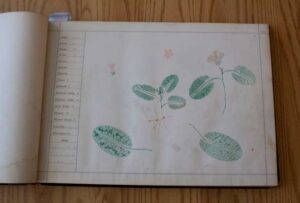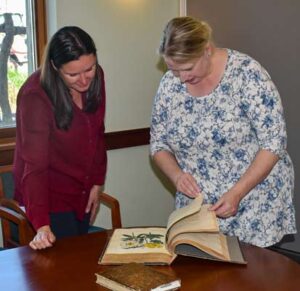By Liz Nye, New England Botanic Garden Staff
September 2023
On a day in late April 1888, a man named John Coulson, head gardener at the Salisbury Estate in Worcester, collected a sprig of Mayflower blooming in the city. Mayflower (Epigaea repens), also known as ground laurel and trailing arbutus, is a much-loved early bloomer heralding spring in the northeast. The native evergreen shrub displays broad, oval leaves that trail on woody stems. Small, sweet-smelling flowers made this plant popular to harvest for garlands and soaps during the nineteenth century. But the Mayflower sprig Coulson collected was likely not destined for soap.

Impressions of mayflower specimen, one of among 234 plant species collected and recorded by John Coulson in 1888.
We know a lot about the sprig. The date the blooms were found — April 29, 1888, the location — Tatnuck Village, the number of flower buds on the specimen — seven, the number of flowers — six, the number of stem leaves — five, and many more taxonomic details all carefully recorded, and not just with notes. Coulson also made colorful nature prints of his finds. Until recently, a bound book of his prints, Impressions of Plants, was housed at the Garden as part of the organization’s rare botanical book collection.
Before cameras were readily available, nature printing enabled scientists, naturalists, and hobbyist collectors to preserve the impression of a plant, animal, or even mineral specimen. The process involved inking objects directly and pressing them to paper. With plants, one had to act fast to make the print before the specimen dried out. Coulson’s Impressions of Plants includes nature prints and hand-written notes detailing a whopping 234 different plant species that he collected in and around Worcester within three months. Each specimen was identified according to Asa Gray’s 1868 Manual of Botany, a seminal reference book of the day. Impressions of Plants features trifoliate ginseng (Panax trifolius), a wetland plant and relative of the rare American ginseng, yellow blue-bead lily (Clintonia borealis), and purple milkweed (Asclepias purpurascens), among other interesting finds. The leaf veins, roots, and petal structure of his Mayflower sprig come alive in shades of green and pink.
With Google at our fingertips and smart phones equipped with plant identification apps, it’s easy to dismiss the present-day value of work like Coulson’s. But in the absence of iNaturalist and PlantFinder, collections of plant impressions as well as herbariums (collections of dried plants) served as field guides and reference books. Today, as human development and climate change alter our landscapes and ecosystems, these collections provide snapshots of regional plant diversity at a moment in time otherwise lost. These records can be valuable to new scientific research, but only if preserved properly and made accessible for study.

Grace Elton (left), CEO of the Garden and Elizabeth Slomba (right), University Archivist and Interim Special Collections Librarian at UNH examine botanical illustrations from the rare book collection.
With these aims in mind, the Garden decided to donate its rare botanical book collection, more than 500 titles, to the University of New Hampshire’s Dimond Library where the items will be cared for as part of the Milne Special Collections and Archives. Many of the books recently gifted were originally owned by Worcester County Horticultural Society founders. The collection features monographs, encyclopedias, herbals, and periodicals, works dating from the early to mid-1800s, with a few items dating to the 1500s. Notable titles include the first edition of John Muir’s “Our National Parks,” and “Incipit Tractatus de virtutibus Herbarium” (1499), an anonymous compilation from classical, Arabic, and medieval sources, originally published in Mainz, Germany in 1484. Some of the books contain incredible botanical illustrations and lithograph depictions of New England-based fruit and flowers.
The University of New Hampshire has professional special collections staff and the facilities needed to protect these rare and precious materials appropriately. They also have plans to make them available to the academic community and the public as well. Funding has already been secured for digital cataloguing which will make parts of the collection more easily accessible to UNH faculty, staff, and students and allow the body of knowledge contained in these rare books to be used by researchers around the world. Future study could span fields from agriculture and plant science to book arts and printmaking. Classes are already make use of the collection this fall.
On September 23, the university will host a special opening reception in the Dimond Library to unveil items from the rare botanical book collection that the Garden gifted. All are welcome to attend. You can learn more and register here!
Liz Nye is the Public Relations Manager at New England Botanic Garden. She holds a master’s degree in science writing from Johns Hopkins University and enjoys learning about and writing about all things plants.
